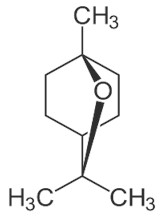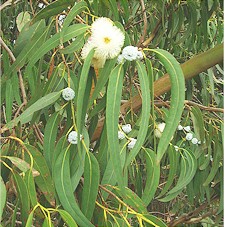Eucalyptol is a natural active ingredient of plant origin used in veterinary medicine mainly in dogs and cats against some external parasites (lice, fleas, flies, etc). It is also used against agricultural and household pests.
Common name: EUCALYPTOL
Other names: 1,8-cineole, cajeputol, 1,8-epoxy-p-menthane, 1,8-oxido-p-menthane, eucalyptole, cineol, cineole
Type: REPELLENT
Some plants where it is found
- Artemisia spp
- Cinnamomum camphora (camphor tree, camphorwood, camphor laurel)
- Cinnamomum tamala (Indian bay leaf, tejpat)
- Eucalyptus spp (gum trees)
- Laurus nobilis (laurel)
- Melaleuca alternifolia (narrow-leaved tea-tree, narrow-leaved tea-tree, snow-in-summer)
- Rosmarinus officinalis (rosemary)
- Salvia officinalis (sage)
- etc.
CHEMICAL STRUCTURE

EFFICACY AGAINST PARASITES
Type of action: repellent
Main veterinary parasites controlled: flies, mosquitoes, etc.
Mechanism of action: Eucalyptol has mainly a repellent effect on some veterinary parasites (e.g. mosquitoes, flies). The repellent effect is rather weak, has not been thoroughly investigated, and the molecular mechanism of action is not known yet. A synergistic effect has been reported when administered together with other natural compounds (e.g. d-limonene).
A "crushing" efficacy should not be expected from natural products, comparable to that of modern synthetic insecticides, which are more potent and persistent than any natural compound. Simplifying, it can be said that natural active ingredients can be useful in places or seasons with low parasite challenge, but may be insufficient for controlling well established parasite populations (fleas, ticks, mites, etc.) in pets, let alone in livestock.
Efficacy against a specific parasite depends on the delivery form and on the dose administered. Check the labels of the products available in your country.
Click here for general information on features and characteristics of PARASITICIDES.
SAFETY
Oral LD50, rat, acute*: 2480 mg/kg
Dermal LD50, rat, acute*: >5000 mg/kg
* These values refer to the active ingredient. Toxicity has to be determined for each formulation as well. Formulations are usually significantly less toxic than the active ingredients.
Eucalyptol is a mild skin and eye irritant. Occasional allergic reactions have been described, mainly in children. It can cause some side effects (e.g. thin feces, light discomfort). Otherwise eucalyptol is considered as rather safe for humans, domestic animals and the environment.
It must be remembered that the natural origin does not guarantee that such compounds are less toxic than the synthetic parasiticides. They are as "chemical" as the synthetic ones. Toxicity is a matter of dose!
General information on the safety of veterinary antiparasitics is available in specific articles in this site (click to visit):
- General safety of antiparasitics for domestic animals
- General safety of antiparasitics for humans
- General safety of antiparasitics for the environment
MARKETING & USAGE
Nowadays eucalyptol is obtained mainly through industrial extraction from the essential oil of Eucalyptus globulus (bluegum, Tasmanian bluegum, southern bluegum). Annual production in the US is estimated between 45 and 2000 tons.
Use in LIVESTOCK: Extremely scarce, mainly as ingredient in some essential oils
Use in HORSES: Extremely scarce, mainly as ingredient in some essential oils
Use in DOGS & CATS: Very scarce
Use in human medicine: Yes, mainly in the food and cosmetic industry
Use in public/domestic hygiene: Yes, mainly in home care products
Use in agriculture: Yes, rather scarce
PARASITE RESISTANCE
Reported in livestock & horses: NO
Reported in pets: NO
Reported in other uses: NO
Learn more about parasite resistance and how it develops.
ADDITIONAL INFORMATION

Eucalyptol is a monoterpenoid produced by numerous plants. It has a characteristic mint-like smell and tastes cooling and spicy. It is abundantly used in the food industry (beverages, candies, sweets), home and personal care products (cosmetics, perfumes, detergents, etc). It is also used in human medicine against cough and in mouthwashes. And it is also one among hundreds of additives used in the tobacco industry.
Eucalyptol makes up to 90% of the essential oil of Eucalyptus globulus (blue gum). Industrial extraction allows a purity of up to 99.8%.
Direct usage in veterinary parasites is so far irrelevant, mainly as a constituent of some essential oils.
Eucalyptol shares two features with many other natural insecticides: it is rather volatile and is unstable when exposed to sunlight. Consequently its effect in animals exposed to sunlight is very short: a few days or even only a few hours. This means that protection of the treated animals against re-infestations (residual effect) is virtually inexistent. This is particularly unfavorable for livestock that would need to be treated very frequently. However, for the same reason they do not leave chemical residues in food commodities (meat, milk, eggs, etc.), which is a benefit sought by organic producers.
Another disadvantage of many "natural products" extracted from plants is that quality (and thus efficacy) may vary, even if used following the label instructions, because producing extracts from heterogeneous plant materials is often less reliable than chemical synthesis.
Finally it must be said that in many countries registration of so-called "natural products" does not need a (serious) proof of efficacy, quality and safety as pesticides or veterinary medicines. This means that many such products have not been seriously tested in clinical trials in the field and consequently their efficacy and/or safety may not be granted. For such products, getting a market authorization does not need a substantial investment, which explains why there are so many brands in most countries.
- Click here to view the list of all technical summaries of natural antiparasitic active ingredients in this site.
- Click here to view the list of all technical summaries of antiparasitic active ingredients in this site.
- Click here to visit the article on medicinal plants with antiparasitic properties in this site.